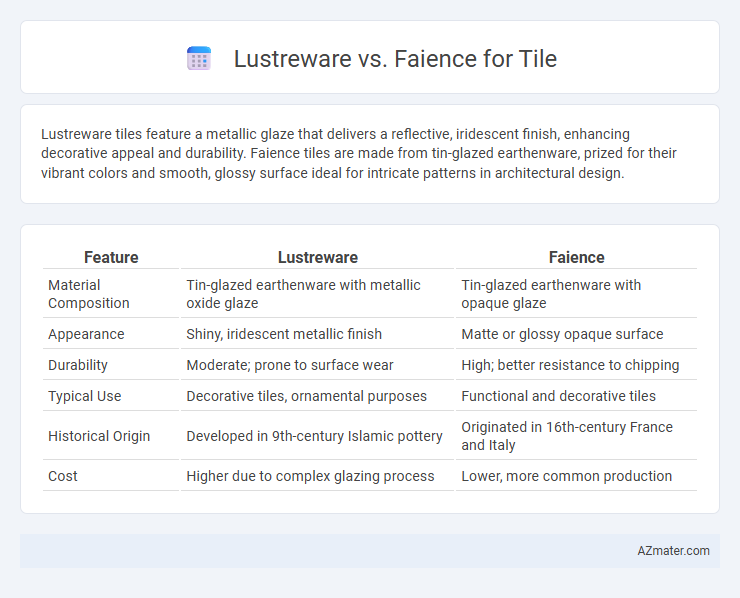Lustreware tiles feature a metallic glaze that delivers a reflective, iridescent finish, enhancing decorative appeal and durability. Faience tiles are made from tin-glazed earthenware, prized for their vibrant colors and smooth, glossy surface ideal for intricate patterns in architectural design.
Table of Comparison
| Feature | Lustreware | Faience |
|---|---|---|
| Material Composition | Tin-glazed earthenware with metallic oxide glaze | Tin-glazed earthenware with opaque glaze |
| Appearance | Shiny, iridescent metallic finish | Matte or glossy opaque surface |
| Durability | Moderate; prone to surface wear | High; better resistance to chipping |
| Typical Use | Decorative tiles, ornamental purposes | Functional and decorative tiles |
| Historical Origin | Developed in 9th-century Islamic pottery | Originated in 16th-century France and Italy |
| Cost | Higher due to complex glazing process | Lower, more common production |
Introduction to Lustreware and Faience Tiles
Lustreware tiles feature a distinctive iridescent glaze that creates a shimmering, metallic effect through the application of metallic oxides, popular in decorative arts since the 9th century. Faience tiles are tin-glazed ceramics characterized by their opaque white surface and brightly colored designs, originating from the Renaissance period and widely used in architectural decoration. Both Lustreware and Faience tiles offer unique aesthetic qualities, with Lustreware emphasizing lustrous shine and Faience highlighting vibrant, opaque glazes.
Historical Background of Lustreware
Lustreware, a distinctive type of pottery characterized by its iridescent metallic glaze, originated in the Islamic world around the 9th century and later influenced European ceramic traditions during the Renaissance. This technique involves applying metal oxides to glazed tiles, creating a shimmering effect that contrasts with faience, which is typically tin-glazed and opaque. Lustreware's historical development highlights its role in luxury tile production, often seen in Persian, Moorish, and Italian decorative arts, making it a significant cultural artifact in the study of ceramic history.
Origins and Evolution of Faience Tiles
Faience tiles originated in ancient Egypt and Mesopotamia, renowned for their vibrant glaze created through a silica-based composition interlaced with metal oxides. Unlike Lustreware, which emerged during the Islamic Golden Age and is characterized by its iridescent metallic finish achieved through a secondary firing process, Faience tiles showcase opaque, glazed surfaces with intricate motifs reflecting cultural symbolism. The evolution of Faience tiles spans from early utilitarian objects to elaborate decorative art forms, influencing tile-making techniques across Mediterranean and European regions over centuries.
Materials and Techniques Used
Lustreware tiles are created using a metallic glaze technique that involves applying a thin layer of metal oxides, such as silver or copper, onto a ceramic surface, which is then fired at low temperatures to achieve an iridescent sheen. Faience tiles, on the other hand, are made from tin-glazed earthenware, characterized by an opaque white glaze that provides a smooth canvas for painted designs and withstands high firing temperatures. The key distinction lies in lustreware's reliance on metallic luster achieved through complex chemical reactions during firing, compared to faience's emphasis on the tin-based opaque glaze and hand-painted decoration.
Visual and Aesthetic Differences
Lustreware tiles feature a metallic, iridescent glaze that creates a shimmering effect, reflecting light with a warm, glossy finish suited for luxurious and artistic spaces. Faience tiles, on the other hand, have a matte or glossy surface with vibrant, opaque colors and often showcase intricate hand-painted patterns inspired by Mediterranean and Moorish designs. The visual difference lies in Lustreware's reflective, lustrous sheen versus Faience's rich, solid color palette and detailed motifs, defining distinct aesthetic appeals for interior or exterior tile applications.
Durability and Maintenance Comparison
Lustreware tiles, known for their iridescent glaze, typically exhibit moderate durability but require careful maintenance to prevent surface wear and fading. Faience tiles, composed of tin-glazed earthenware, offer superior durability with a hard, scratch-resistant finish and are easier to clean due to their non-porous surface. Choosing between Lustreware and Faience for tiling depends on the specific balance of aesthetic appeal versus long-term durability and minimal maintenance needs.
Applications in Architecture and Interior Design
Lustreware tiles, known for their iridescent glaze, create striking visual effects ideal for decorative walls and focal points in interior design, enhancing spaces with a luminous, antique charm. Faience tiles, crafted from tin-glazed earthenware, provide a durable, matte finish suitable for both indoor and outdoor architecture, often used in historic restorations and Mediterranean-style facades. Both materials offer versatility in architectural applications, with lustreware favored for artistic accent features and faience prized for its structural resilience and vibrant color retention.
Cost and Accessibility
Lustreware tiles generally command higher prices due to their intricate metallic glaze and limited production, making them less accessible for budget-conscious projects. Faience tiles, crafted with tin-glazed earthenware, offer a more affordable and widely available alternative, suitable for large-scale tiling needs. The cost-effectiveness and accessibility of faience make it a practical choice compared to the premium luxury associated with lustreware.
Environmental Impact and Sustainability
Lustreware tiles, created with metallic glazes, often involve energy-intensive kiln firings that contribute to a higher carbon footprint compared to faience tiles, which use tin-glazing techniques requiring less heat and fewer hazardous materials. Faience tiles are typically more sustainable due to their natural clay bases and lower emissions during production, supporting eco-friendly building practices. Choosing faience over lustreware reduces environmental impact by minimizing energy consumption and toxic waste, promoting greener tile manufacturing.
Choosing Between Lustreware and Faience Tiles
Lustreware tiles offer a reflective, iridescent glaze that enhances visual appeal with vibrant, metallic hues, making them ideal for decorative accents. Faience tiles are known for their tin-glazed surface that provides a matte, opaque finish with intricate painted designs, perfect for traditional and artistic applications. When choosing between lustreware and faience tiles, consider the desired aesthetic effect and durability, as lustreware thrives in glossy, high-shine settings while faience excels in detailed, matte decorative surfaces.

Infographic: Lustreware vs Faience for Tile
 azmater.com
azmater.com